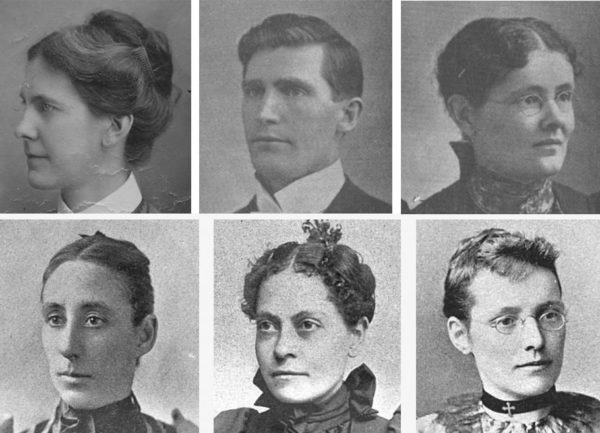03 May On This Day in UB History: May 3 (Turmoil in Sierra Leone)

Mary Mullen (upper left) and the five missionaries murdered at Rotufunk. Top: Isaac and Mary Cain. Bottom (l-r): Dr. Henrietta Hatfield, Dr. Mary Archer, and Ella Schenk.
May 3–two days, 94 years apart, both set amidst national upheaval in Sierra Leone. A day of tragedy for missionaries, and a day of rescue.
On May 3, 1898, five missionaries with the “liberal” United Brethren church were massacred in Sierra Leone. Two more were soon murdered elsewhere. Just like that, seven of the eight missionaries supported by the Women’s Missionary Association were dead. Killed in the Hut Tax War, which was sparked by grievances against the British government.
Although our denominations had split nine years earlier, the ties ran deep, and our goal was the same–to evangelize the people of Sierra Leone.
None of our own missionaries perished. Mary Mullen, who had arrived six months before, served by herself at Momaligi. She found herself at the hands of five young men brandishing blood-stained clubs and swords, which they had used to massacre people in another village. As she sat in her house awaiting her fate, a boat carrying five well-armed policemen pulled up to the wharf. She ran to the boat, and they quickly pushed off. Before long, Mullen was on a ship to England.
UB missionaries Daniel and Elizabeth Wilberforce, along with their four children, fled into the bush as a war party approached Gbangbaia. They hid for several days as warriors passed closely by. The mission buildings at both Momaligi and Gbangbaia were destroyed.
The five Americans at Rotufunk fled into the bush, but were caught. As the rebels surrounded them, Rev. Isaac Cain, standing next to his wife, reportedly held a revolver in his hand. He threw it aside and stated, “I will not have any man’s blood on my hands.”
One of those missionaries was Ella Mary Schenk, a UB preacher’s kid from Willshire, Ohio. In 1891, at age 25 and with a teacher’s degree in hand, she sailed for Sierra Leone to become matron of a girls’ boarding school in Rotufunk. During her first term, following the death from illness of two fellow missionaries, Ella wrote, “I can think of nothing that would make death more welcome than to meet it here, to die for these dear children as my Savior died for me.”
As the other missionaries were hacked to death, Ella was taken into a building and repeatedly raped. Then, she too was slain. The rebels torched all of the mission buildings, and left the five bodies lying amidst the burning ruins.
————————–
On Sunday, May 3, 1992, upon orders from the US Embassy, over 30 United Brethren missionaries left Sierra Leone aboard a US military transport.
A coup had occurred four days earlier. The embassy had warned U. S. citizens to pack a bag, get their travel documents ready, and be prepared to leave. On May 1, they issued an evacuation notice to all U. S. citizens in Sierra Leone.
At the time, we had 34 missionaries in Sierra Leone—18 adults and 16 children. Most of them lived in Mattru. Two-way radio linked all mission stations, and Mattru Hospital and the Freetown mission house did radio checks every morning and noon. However, because of a broken antenna in Freetown, the Mattru missionaries didn’t learn about the evacuation order until 8 am Saturday. They hurriedly packed (one suitcase and one carry-on) and arranged to turn everything over to nationals—including a very busy hospital filled with patients.
By 10:00, the missionaries had loaded everything into three vehicles and were headed for Freetown, about 180 miles and seven hours away. After about 75 miles, they rendezvoused with June Brown and a woman serving with the United Methodist Church (now, after mergers, the denomination of those slain Rotufunk missionaries). June was preparing to end a 35-year missionary career in Sierra Leone. Numerous farewell events had been planned, but the evacuation interrupted them.
The missionaries arrived in Freetown around 5:00 Saturday night. The city seemed calm, though they saw many guns. They stayed at a hotel on the outskirts of town, and left for the airport on Sunday morning.
The State Department had organized the evacuation extremely well in what was essentially a military operation. The embassy rented the hovercraft which took everyone across the bay to the airport, and brought food and drinks to everyone. Tom Datema was impressed by the politeness and efficiency of the State Department and U. S. soldiers.
Our missionaries had a choice of two destinations: Frankfurt, Germany, or Dakar, Senegal. They chose Dakar, partly because the State Department would bill us for the flight, and Dakar would be cheaper. About 2:00 that afternoon, they boarded a huge U. S. military transport. Women and children sat in hammock seats along the side, while men sat on the floor hanging onto a big strap.
From Dakar, the missionaries went in several directions. Some went to Paris, some to Brussels, and then on to New York. June Brown stayed overnight in Dakar and then flew straight to New York, arriving just a few hours after the others—but with an extra night’s sleep.
Missionaries began returning to Sierra Leone in August. But the rebel war only got worse, and within two years, the Board of Missions decided to withdraw all UB missionaries from the country.

No Comments